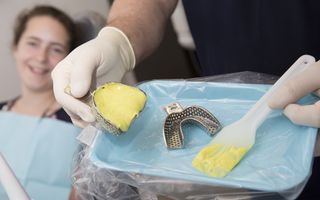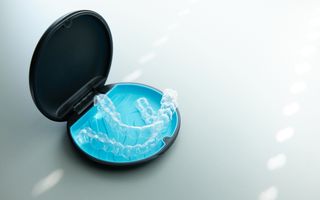
Orthodontics
Correcting tooth alignment with aligners, braces and orthodointic plates
Orthodontics
Correcting tooth alignment with aligners, braces and orthodointic plates
Richmond Fine Dentistry takes a holistic approach to oral health through a wide range of orthodontic treatments, targeted at all ages – from children through to adulthood and older age.
What is Orthodontics?
Orthodontics is the branch of dentistry that specialises in the diagnosis, prevention and treatment of dental and facial irregularities (malocclusion). Malocclusion is a technical term for when teeth and jaws don’t align properly. These problems may be inherited or acquired through habits from a young age.
Why correct malocclusion?
A malocclusion may contribute to speech impairments and increase the risk of trauma if teeth are prominent. Abnormal or uneven wear of tooth surfaces can also occur if there is poor alignment of the teeth or jaws. In cases of deep bite, the lower front teeth can bite into the gum behind the upper front teeth causing damage.
Crowded and overlapping teeth are harder to clean and can increase the risk of tooth decay, gum disease and eventual tooth loss. Having your teeth straightened will make it easier for you to look after them. Orthodontic care has broad-reaching health benefits, far greater than just straightening teeth and improving the appearance of your smile.

Start your orthodontic treatment with us
Any dentist may carry out orthodontic treatment, but the vast majority of cases are handled by specialist orthodontists who have restricted their practice to orthodontics exclusively. Some severe orthodontic cases also require oral and maxillofacial surgery. We can coordinate the course of care by appropriate referral to specialists.
At your child’s first dental visit, we start looking at facial habits, muscle patterns, breathing function, facial proportions and of course, the position of their baby teeth. From as young as 7 we can start with a Myobrace program to ensure the correct development of the jawline and correct tongue resting position.
As an older child or as an adult, the intervention options broaden to include treatments such as Invisalign, Myobrace, braces, removable appliances or headgear to move the teeth or jaws into an ideal relationship.
When should I begin orthodontics?


Length of Treatment
On average, orthodontic treatment using braces is approximately 18–24 months in duration. However, the length of treatment will depend on the severity of the original malocclusion as well as the type of treatment carried out, and the cooperation of the patient. In the case of braces, on completion of the active part of orthodontic treatment, the braces will be removed and retaining appliances (retainers) are fitted to hold the teeth steady in their new position. These appliances may be removable plates or wires fitted behind the teeth. Retainers play an important role in orthodontic treatment, if they are not worn according to instructions, the teeth may move back towards their original position.

Orthodontic Issues to be aware of
Tooth decay, gum disease, and permanent markings (decalcification) on the teeth can occur if orthodontic patients eat foods containing excessive sugar and acids and allow plaque to accumulate around braces. This may occur without orthodontic treatment but the risk is greater when wearing braces. Inflammation of the gums and loss of supporting bone can occur if bacterial plaque is not removed regularly with good oral hygiene. Be sure to continue to visit Richmond Fine Dentistry at least every 6 months while orthodontic treatment is progressing. Use of fluorides and tooth conditioner is highly recommended.
Teeth may have a tendency to change their position after treatment. This is called relapse. The faithful wearing of retainers should reduce this tendency. Teeth can however, move at any time whether or not they have been orthodontically treated. This may be caused by growth and maturational changes, mouth breathing, playing a musical instrument and other oral habits.
Where a tooth has been injured by a previous accident or contains a large filling, damage to the nerve of the tooth may result. In rare instances, this may lead to loss of tooth vitality and discolouration of the tooth requiring root canal treatment or other dental treatment to restore the colour of the tooth.
The total time required to complete treatment may exceed the estimate. Poor cooperation, poor oral hygiene, broken appliances and missed appointments can lengthen the treatment time and affect the quality of the result. Cooperation throughout treatment is your contribution to a pleasing appearance and good bite. Failure to cooperate may require the orthodontist to change the goals of your treatment.
General medical problems can affect orthodontic treatment. You should keep your orthodontist informed of any changes to your medical health or any medication you may be taking.
Braces may cause some irritation to the soft tissue of the mouth. If improperly handled, the headgear may also cause injury to the face or eyes. Patients are warned not to wear headgear during times of rough play or competitive activity. Although our headgears are equipped with a safety system, we urge caution at all times.
It is strongly recommended that you obtain a special mouthguard if you play any form of sport that may result in injury to the teeth. Talk to us at Richmond Fine Dentistry, we can construct and fit specialised orthodontic mouthguards.
Successful orthodontic treatment depends on the understanding and cooperation of the patient. Although there are many benefits to be gained from orthodontic treatment, there are also potential risks associated with this type of treatment. Although these risks are generally not serious, they still should be considered when making the decision to undergo orthodontic treatment.
Orthodontic Options
Myobrace – Muscle Training System

We are very excited to add Myobrace to the list of treatments we provide. Many people do not realise that developing the correct facial muscle habits and correct nasal breathing at a young age is important for health in many ways. Benefits include sufficient growth of the jaws in optimal proportions to fit all the adult teeth in the mouth. This is where Myobrace can help.
What is Myobrace?
Myobrace is a muscle training system which encourages correct jaw growth in children so their dental arches form correctly, allowing space to fit their erupting teeth, with enough room for the adult teeth to come through straight.
How does Myobrace treatment work?
The optimal age to treat children with Myobrace is 6–10 years old. They only need to wear the specially made brace for a few hours in the day and overnight. Coupled with ‘myofunctional exercises’, this creates real and lasting change to the teeth, tongue and jaw alignment, leading to optimal facial development and a straight smile.
Find out more information about Myobrace.
Invisalign – Clear Braces

We are a trusted provider of Invisalign services to Melbourne.
What is Invisalign?
Invisalign is the modern and effective technique of using a series of plates to realign teeth. It is not useful in all orthodontic cases, but definitely appropriate for some patients suffering from malocclusion.
How does Invisalign work?
Invisalign uses clear aligners created specifically for your own mouth to gradually and gently move your teeth into place. Every couple of weeks a new, specially modified aligner is worn until treatment is complete.
Find out more information on Invisalign.
Smilefast

Smilefast is a new orthodontic technology we are proud to offer at Richmond Fine Dentistry, and have received great results with. Smilefast is a form of fixed brace that is much quicker than other options, requiring around 6–9 months for treatment. With clear and white brackets and wires, it also has a discreet appearance.
Find out more information on Smilefast.
Contact us today for more information or to book an appointment for a Myobrace consultation.
Frequently asked questions
The price of dental braces will vary dependant on a number of factors... such as the length of time you will need to wear them, how many consultations and adjustments you need and other factors tha will be specific to you.
While braces are highly effective, they do usually come with discomfort as your teeth move into new positions. This usually lasts for a few days after first having them applied, and after adjustments, where your teeth and gums will feel tender.
During these days, you can manage pain with over-the-counter pain medications and eat a diet of soft foods - ie. no apples, uncooked carrots, hard biscuits, etc.
Yes! Dental technology has come a long way from the early days of metal braces, and clear aligners are now just as effective as metal braces.
An orthodontist is a specialist who works to ensure your teeth are straight and your jaw is aligned. They will prepare your teeth for orthodontic treatments, carry out treatments such as braces, maintain and adjust appliances as needed, and keep ongoing appointments with you as you transition out of treatment.
A dentist is your general expert on your teeth, gums, and oral health. They will perform your check-ups, complete treatments such as fillings, root canals, and crowns, and help you work on your health.
An orthodontist is a specialist who focuses on teeth straightening and alignment and can apply braces and other orthodontic treatments.
Once your orthodontic treatment is completed and your braces are removed, you will be fitted with a retainer to ensure that your teeth remain in their new alignment.
Be sure to wear your retainers as directed, or you may undo all the previous work. Do not wear your retainer while eating, and be sure to brush it before you insert it into your mouth.
For patients who do not wish to use a removable retainer, a permanent wire retainer can be cemented to the back of the teeth to keep them in place.


